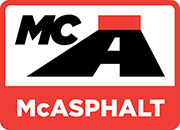Cape Seals
A cape seal is a combination of a single-chip seal application followed by slurry seal or micro-surfacing. The slurry or micro-surfacing application helps fill the voids between the chips. The slurry bonds the chips to prevent loss, while the chips prevent undue traffic abrasion of the slurry. Cape seals are often used because of the aesthetics of the finished surface. Inverted cape seals are often used as a rut filled followed by a single-chip application for an economical solution to wheel path pavement deformation.
Design Criteria
When designing a cape seal a number of factors have to be examined and assessed to ensure a proper surface will be placed that will perform for its service life. A properly designed chip seal and slurry seal should be completed prior to construction. The compatibility of the emulsions to be used should be checked against the aggregates. The quantity of slurry seal should be closely monitored so that the proper amount is placed such that the larger chip seal particles show through the slurry seal.
If these factors are taken into consideration in designing the cape seal then the chances of a successful seal are greatly improved.
Materials
Asphalt Emulsions:
A number of different grades of asphalt emulsion can be used in cape seals. The proper emulsion to be used for chip seals has to be determined by running compatibility tests between the emulsion and the aggregate to be used. Typically the most common emulsions used are RS-1, RS-2, CRS-1 and CRS-2. The slurry seal would normally use a CSS-1h, SS-1h or quick set type emulsion.
Aggregate:
The type of cover aggregate used in chip seals must meet certain requirements of shape, size, cleanliness and surface properties. The aggregate should be single sized and cubical in shape. The number of flat and elongated particles should be kept to a minimum so that the proper quantity of asphalt emulsion can be applied to hold the stone in place. Also the asphalt emulsion to be used and the aggregate must be compatible to ensure the asphalt-aggregate bond is effective.
The type of mix aggregate used in slurry seals must meet certain requirements of shape, size, cleanliness and gradation. The asphalt emulsion to be used and the aggregate must be compatible to ensure the asphalt-aggregate bond is effective.
Performance Guidelines
In order to construct a proper well designed sand seal the following guidelines should be followed:
- Design a chip seal with aggregate to be used on job
- Use a clean coarse aggregate
- Ensure compatibility of aggregate and emulsion
- Design a slurry seal with aggregate to be used on job
- Ensure compatibility of aggregate and emulsion
- Calibrate and inspect all equipment
- Follow proper construction techniques
- Use traffic control to protect seal
- Work only in weather suitable for type and grade of emulsion being used
